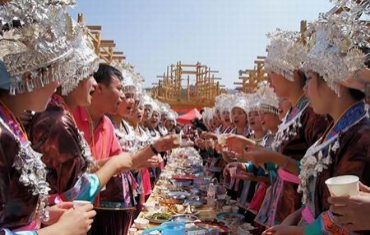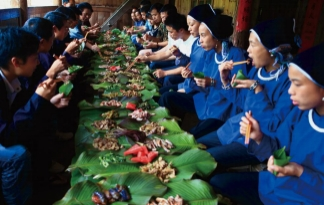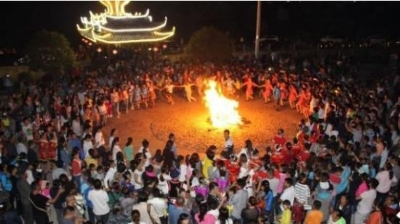Dong is one of the 56 minority nationalities in China. Dong people mainly live on the border areas of Hunan and Guizhou provinces, and Guangxi Zhuang Autonomous Region in south China. Relatively speaking, Dong is an ethnic minority with a long history and big population. Statistics show that the total population of Dong has reached more than 3.2 million by the end of 2020. They have not only their own belief and dialect, but also rich and unique folk culture and customs, among which Helongyan(Joint Banquet) is the most representative one. The name of Helongyan consists of three Chinese characters “合拢宴”. The first two “he-long (合拢)”means connecting a number of tables or wooden planks in a row, and the other “yan(宴)” refers to a big feast or banquet. This article is about the Helongyan held in Xinhuang County, west of Hunan province, which has ever been recorded as the largest and longest banquet in the world by Guinness World Record.
Dong people from Xinhuang are very warmhearted and hospitable, always trying to treat their guests well, especially those from a far place. When some distinguished guests come to a Dong village, traditionally the hosts from a few families or even from the whole village would entertain the visitors together by holding a joint banquet---Helongyan. If the dining room isn’t big enough, they would find a large open space to keep a number of tables in a straight line or in a round circle. On the tables are various kinds of delicious food made by different households. Then the hosts and guests would sit at the tables to enjoy the food together. Helongyan presents the typical hospitality of Dong people. Attending Helongyan is supreme honor for the guests, because only the most distinguished ones deserve this kind of grand reception.
I. Tradition of Helongyan
Dong people are usually very kind and hospitable. They keep a long tradition of “scrambling” for guests, namely each host trying to get more guests than others. On some special occasions or grand festivals, Dong people keep a tradition of visiting each other among different villages. The moment when they reach their destination would throw the host villagers into a chaotic scramble for guests, presenting an extraordinarily lively and interesting scene. Naturally, some people would fail to get any guests because the number of the visitors can’t always be large enough to meet everybody’s need, and thus they would ask those getting several guests to spare one or two to them. If they are declined to get any guests, they would make a request to entertain all the guests together by having a joint banquet and every household would provide the banquet with some delicious food. If they don’t have such a big table to keep so much food for so many people, they would add a few tables in line or even connect the tables with wide and long wooden planks, thus Helongyan comes into being. Dong people have been keeping this tradition for hundreds of years.
Nowadays, it has become a common practice for Dong people to have a Helongyan when they entertain distinguished guests or have grand celebrations. A Helongyan consisting of long tables or wooden planks can be extended indefinitely as required, reaching tens or even hundreds of meters long if necessary. The guests and the hosts would sit opposite each other on either side of the tables, singing and dancing, drinking and laughing, full of fun and zest.

A Helongyan
II. Legends of Helongyan
There are quite a lot interesting folk stories about Helongyan, but the most legendary ones are the two as follows.
One originates from the uprising of Dong people in the early Ming Dynasty. From the year of 1378 to 1385, due to the armed conquest and tyrannical demands of the Ming Administration over the Dong ethnic groups, a large-scale armed resistance of the Dong people was aroused across the border areas of Hunan and Guizhou provinces, and Guangxi Zhuang Autonomous Region. Mr. Wu Mian, the rebelling leader, was respected as a national hero by the Dong people. Wherever he went, he would be worshipped as a god by the locals. One day, he passed a Dong village with his insurrectionists and was warmly welcomed by the villagers. Everyone was eager to entertain the hero and none was willing to give up the opportunity, which caused an awkward situation. Then, a smart girl from the village came up with an idea, entertaining their hero together by holding a joint banquet. So, the villagers brought some tables and connected them with some wooden planks on an open space in the village and offered various kinds of delicious food made by themselves. As a result, a joint banquet Helongyan came into being.
The other is from two brothers. Once upon a time, two brothers hurried on to take part in a yearly-held singing gala of the Dong nationality, but they were stopped by a flooding river on the way to their destination. The young men tried to cross the river by boat but fell into water in the middle of the river because of the roaring waves and of their panic and inexperience. Fortunately, at the critical moment, a fisherman, who happened to be on a boat nearby, rushed to their rescue and saved them from the turbulence. A few years later, the fisherman paid a visit to the village on business where the two brothers lived. However, he was busy and could only spare half a day to stay in the village, so the brothers, together with their family members and relatives, held a grand reception to reward him for his life saving years ago. Since then, it has become a custom for the Dong people to entertain honored guests with a joint banquet.

A Helongyan
III. Activities of Helongyan
(1) Drinking “Zhuan-zhuan wine” and enjoying “Zhuan-zhuan dishes”
To show hospitality and friendship, at the beginning of the banquet, a respectable and senior man, usually head of the village, would make a welcoming speech on behalf of all the hosts. Then, he would lift up his bowel full of wine to propose a toast to the guests. And the other hosts and all the guests would follow suit by lifting up their bowels to share a toast with each other. Afterwards, they would begin to drink “Zhuan-zhuan wine” (wine passed from person to person). That’s to say, instead of drinking the wine in his own bowel, everyone drinks the wine in the bowel of the person sitting next to him and toasts to each other at the same time. Then, each bowel would be passed in turn from person to person at the table, either starting from left to right or vice versa, until each person drinks the wine in the bowel of everyone else.
Similarly, they would enjoy “Zhuan-zhuan dishes” too; namely, every dish would also be passed in turn from person to person until everyone at the table can enjoy each of the food. The food for the feast is rich in variety; all made by the villagers themselves, mainly including pickled fish and bacon, chicken, duck, pork, mutter, beef, eggs, and vegetables etc, as well as all kinds of home-made wine, rice, and glutinous rice cakes, etc.
(2) Holding a bonfire party
To show their happiness and hospitality, the villagers would have a variety of activities during the banquet, including playing Lusheng, singing folk songs, and dancing around the table. However, holding a bonfire party is the most representative one and a must to them. When night falls, they would light the firewood on an open square and move around the big fire, hand in hand, dancing and singing. The scene is very cheerful, bringing the festival atmosphere to a climax.

A Bonfire Party
(Translated by Chen Min)
